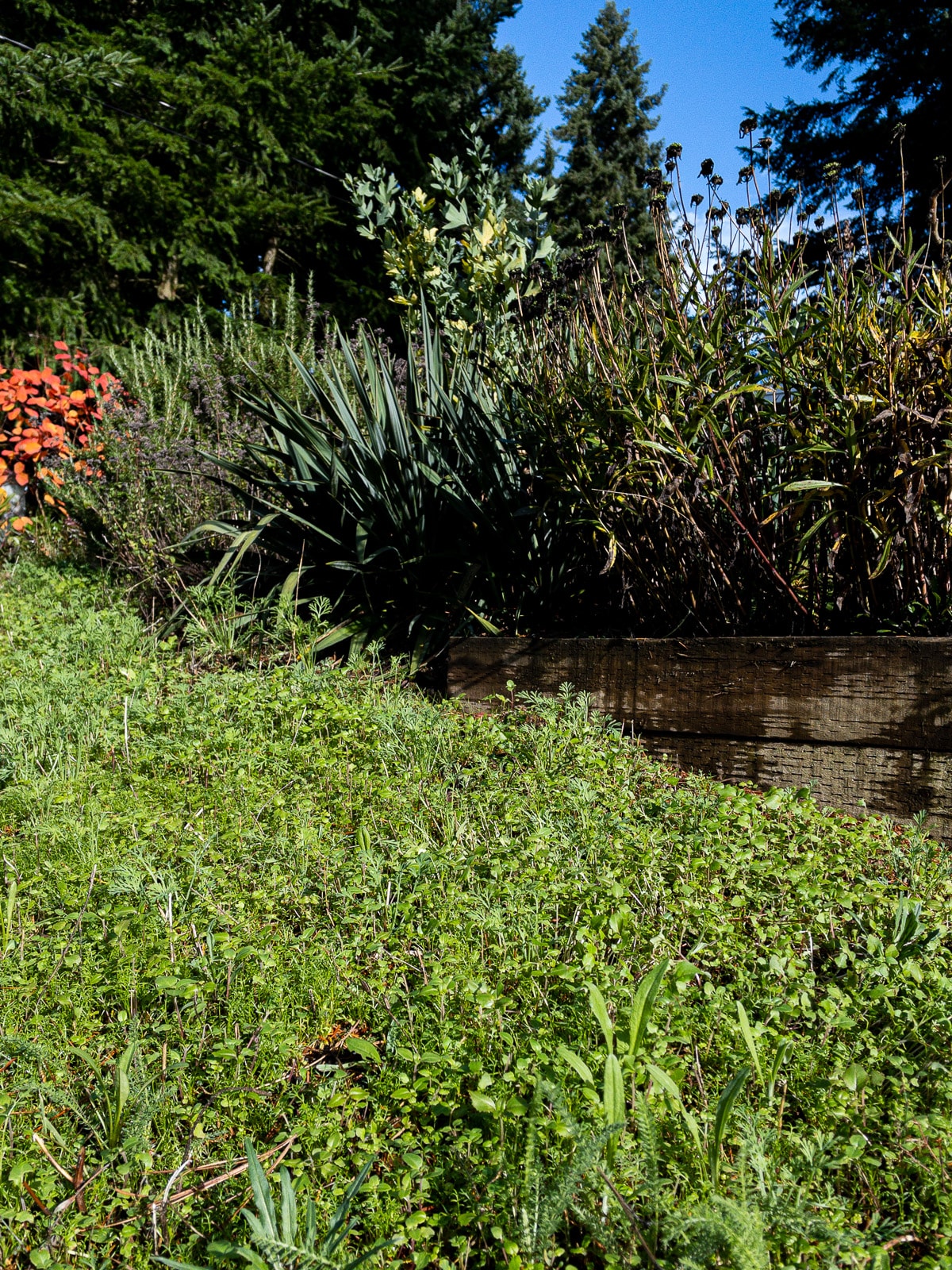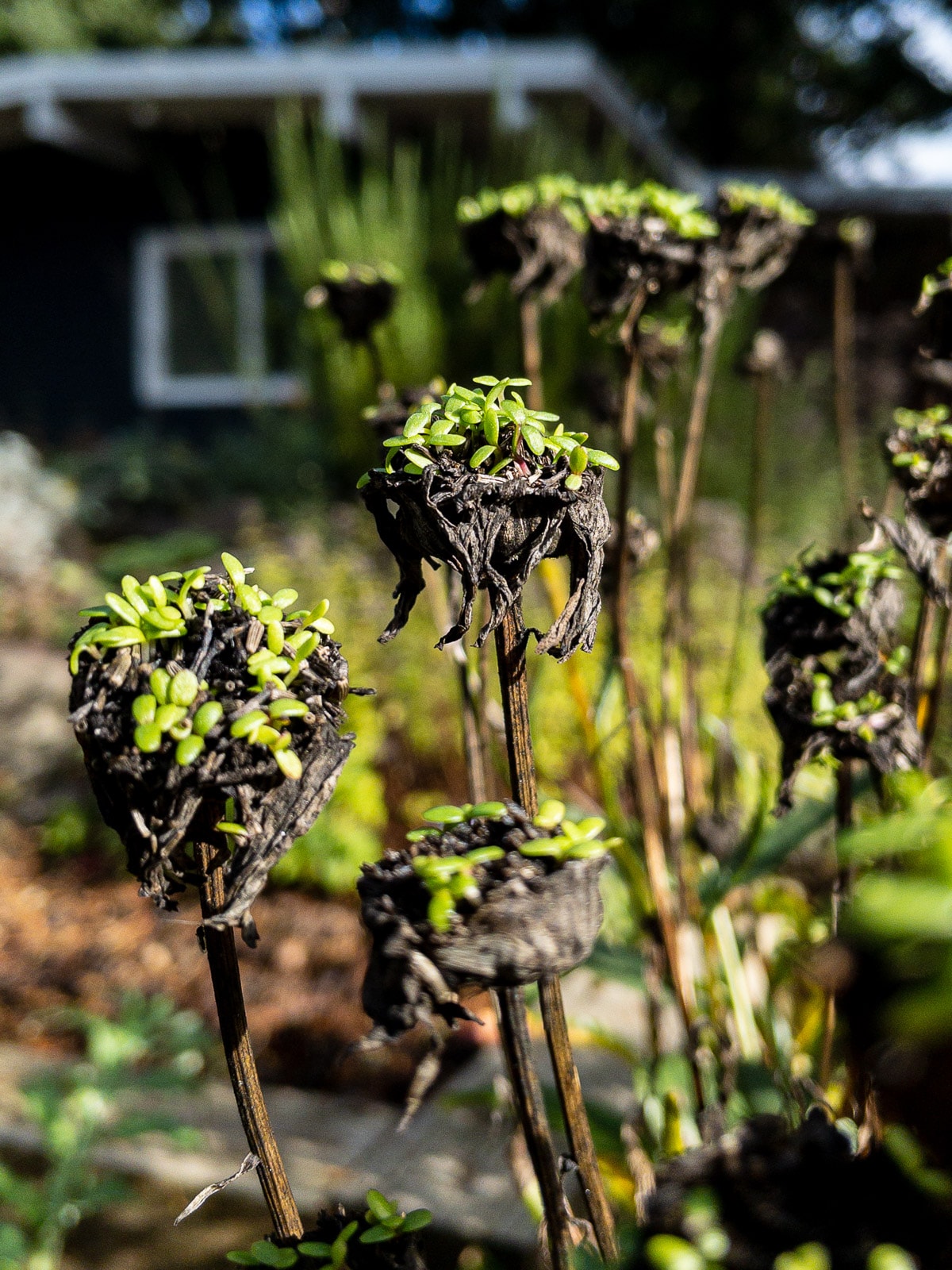
Look at this November 6 afternoon. Native wildflower seeds that fell in late summer have sprouted and made a soft carpet more lush than the nearest moss-choked lawn. Now we’re halfway through the Month of Thanksgiving and in between atmospheric river events I’ve walked around the yard and noticed a whole lot of green. Sure, the native evergreen trees and plants keep Seattle feeling vibrant all year long, but there are native roses with new leaves, annuals looking better than they did in April, and perennials putting out new growth.
It’s rained almost nonstop for a month, and temperatures have hung in the 50s. Yesterday, Seattle tied its Nov. 15 record with a high of 62° at 10am. The warm air that rode in on the rivers is rushing away quickly though. Today we’re back in the 40s. But expecting sun. Which means I’ll go outside and once again wonder… how normal is this:


A spent shasta daisy. With sprouts. Having resisted the urge to cut off the blackened heads in the fall, the rain came in October, turned relentless, and soaked the seeds where they stood. Now these plants look more like chocolate cake pops dotted with bright green frosting. For over three weeks they’ve grown, clearly satisfied with the soil-like conditions the other seeds are providing, and the ample water that pools in the seed head.
A common refrain in the push for more natural or native gardens is to leave seed heads on through winter. Wait until Spring, and then remove them. This is taken to artistic heights, with the combination of uncut dried grasses—add a misty morning and a dead garden comes alive. Leaving everything in place over the winter is practical, too, providing shelter, protecting the ground, and preserving a food source.
If you’re reluctant, just think of the effort saved. In my experience, summer deadheading in hopes of more flowers is hardly worth the trouble. If you have cut flower garden, sure, go for it, but in a normal yard, I’ve found that cutting expired flowers from their stalks mostly promotes growth at the ground level. Diverting the energy spent on seeds to the roots and basal growth may be helpful in establishing new plants. But on the whole, it seems better to just let the plants do their thing. Especially the experienced native plants that have been at this far longer than us.

So what about this hybridized flower? The shasta daisy was a cross of three European flowers, and that triple hybrid was then crossed with a Japanese plant. Engineered AF but not unattractive to insects—few if any bees visit but it’s busy with wasps, hoverflies, and beetles in summer.
Before October I’d never seen the seeds on a perennial sprout from its head. I’ve been looking around for other examples in the neighborhood, without luck. This non-native dwarf cultivar isn’t invasive like an oxeye daisy, which spreads aggressively by rhizomes, and these plants are trapped by timbers anyway. I don’t need more of them but now it’ll be hard to resist experimenting with these individual, naturally-formed seed trays. I’ll likely leave most of them where they are, to see what happens during the winter. Some, I’ll remove and plant in the ground whole. And I’ll cut a few stalks and lay them down, as if fallen, to see if any find soil and persist.
It might all add up to nothing. This might be a weird coincidence of weather. The shasta daisy is a common cut flower that would probably make a garden designer roll their eyes. But I think these sprouting heads are cool. They might even prove useful.

BOOKMARK
I’ll end another post with a book. Last time, I mentioned Dune, a novel that to me was more eco-fi than sci-fi. After I learned the author spent most of his life in the Pacific Northwest, the weeks of rain that followed made me laugh. Frank Herbert said that he was inspired by a trip to the Oregon Dunes, but it’s easy to imagine him feeling trapped in a particularly rainy Northwest week and dreaming of opposite conditions.
George R. Stewart, on the other hand, steered straight into the tumultuous weather he witnessed off the coast of California. In 1941 he published Storm, a novel whose protagonist is literally a storm that develops near Japan and makes it to the West Coast and then across the United States. It’s written with a specificity and accuracy that nonfiction hardly reaches. From the perspective of mostly unnamed characters—workers employed to keep the lights on and the roads clear—a storm named Maria develops from first breath to old age.
Stewart’s biographer called it “the first ecological novel,” and the story is credited with inspiring the National Weather Service to name tropical storms. (A Junior Meteorologist secretly names the storms he’s tracking after girls he’s known.) It’s straight-forward, detailed, and gripping. The book begins in November and has twelve chapters, named “First Day,” “Second Day” … “Twelfth Day.” I haven’t finished it yet but so far it’s a fascinating look at pre-digital weather tracking, the ways we’re all connected, and a reminder that the reason everyone talks about the weather, is because the weather talks to all of us.